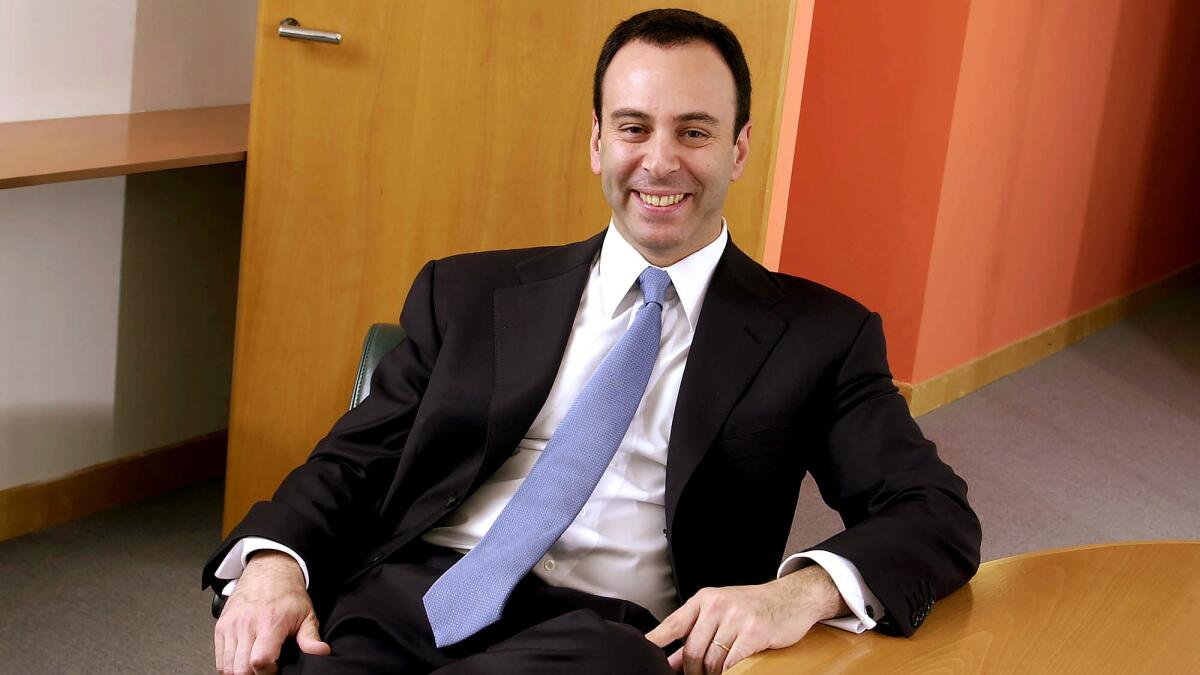Sears files for bankruptcy, will further shrink operations

- Share via
What seemed inevitable is now official: Sears is bankrupt.
Once the most dominant retailer in America, Sears Holdings Corp. — which also owns the Kmart department-store chain — filed for Chapter 11 reorganization under the U.S. bankruptcy laws late Sunday night.
The widely expected filing in U.S. Bankruptcy Court in New York culminated a long, slow decline for the 125-year-old Sears. Like a critically ill patient enduring multiple surgeries to survive, the company repeatedly had shed loss-ridden stores and other assets in recent years, among other restructuring steps, in hopes of having enough cash to stave off bankruptcy.
It didn’t work. Under the stewardship of hedge-fund manager Edward Lampert — Sears’ chief executive, majority stockholder and major creditor — Sears failed to keep pace with more prosperous rivals and adapt to the surge of online shopping and the trouble plaguing bricks-and-mortar stores.
Sears’ sales fell, its losses grew and the company became a shadow of its former self, suffocating in debt. The Hoffman Estates, Ill., chain once was an iconic fixture for value-conscious American shoppers, and its mail-order catalogs were nearly as ubiquitous as Bibles in U.S. homes in the decades long before the arrival of the internet and online commerce now led by Amazon.com.
At a Sears store in Baldwin Hills on Sunday afternoon, the parking lot was less than a third full and a smattering of shoppers meandered through aisles lined with Christmas pajamas and holiday layaway signs.
“As I’ve gotten older and made more money, Sears has not been my go-to store,” said Angela Parker, 42, who came to the store with her mother and aunt after hearing news of the possible bankruptcy filing, to see if that meant bargain prices.
“It’s sad, but things change, that’s the way it is,” Parker said. “People are shopping differently.”
Sears has lost $6.8 billion during the last five years, and its annual sales plummeted to $16.7 billion in its fiscal year that ended Feb. 3 from $36.2 billion in fiscal 2013.

Sears also slashed its store count by more than half during that span, and its number of U.S. employees plummeted to 89,000 from 226,000. But it wasn’t enough.
Sears’ shares, which topped $140 in 2007, closed Friday at 41 cents, giving the company a total stock market value of only $45 million.
The question now is whether Sears will be able to successfully reorganize under Chapter 11, with likely fewer stores, or whether it might eventually be pushed into a liquidation that would end the storied brand, such as what happened this year with Toys R Us Inc.
As of Feb. 3, Sears had operated 547 Sears stores, including 70 in California, and 432 Kmart stores, including 55 in California.
But in subsequent months, Sears closed additional unprofitable stores nationwide, and as of Aug. 4, it had 506 Sears stores and 360 Kmart outlets. Sears also said in a Sept. 13 government filing that it planned to close 149 more stores in the second half of this year, which would drop its total store count to just above 700.
As part of its bankruptcy petition, Sears’ banks agreed to provide a so-called debtor-in-possession loan of $300 million, and is negotiating an additional $300 million in financing from Lampert’s firm, to help the company keep operating through the crucial holiday shopping season.
The deal also calls for Sears to close an additional 142 stores by the end of this year.
Sears also said Lampert had stepped down as Sears’ chief executive but would remain chairman. Sears also created an office of the CEO that will include three other top Sears executives.
Sears also previously sold its proprietary Craftsman brand of tools last year to raise cash and was considering selling its Kenmore appliance division to Lampert’s hedge fund, ESL Investments Inc., for $400 million.
Whether Sears can profitably continue with its current business model, even after a reorganization, is an open question. A Sears shopper has been able to browse for clothing, a major appliance, tools and an array of other items under one roof — all while getting a new battery or tires for the car at an attached Sears Auto Center.
That everything-under-one-roof strategy once was a formula for big profits, but in the modern world, a typical Sears faces stiff competition from discount general merchandise chains such as Walmart Inc. and Target Corp. and from retailers that focus deeply on a niche, whether it be apparel, electronics or home-improvement goods.
On Sept. 23, Lampert and ESL had proposed another major restructuring plan to rescue Sears before a bankruptcy filing would be needed. But in the meantime, cash-strapped Sears faced $134 million of debt that is due Monday, which might have compelled the bankruptcy filing.

Lampert’s hedge fund has provided hundreds of millions of dollars in loans to Sears, making the 56-year-old billionaire both a major equity holder and a creditor of Sears.
With a net worth Forbes estimates at $1.6 billion, Lampert owns 54% of Sears’ stock, according to Sears’ latest proxy statement.
He’s been criticized at times for stripping assets from the struggling retailer for ESL’s benefit, and for failing to invest enough in Sears’ stores and marketing to help the company compete.
It’s all a far cry from the days when Sears held a premier role in U.S. retailing, long before Walmart became a behemoth and Amazon was born.
“There are less people here, it’s not like before,” Roberto Melendez, 58, a retired baker who was looking for jeans at the Baldwin Hills store while his wife shopped at Macy’s.
Melendez said he’s always turned to Sears in every city he’s lived in for about 20 years — Chicago, Miami, Dallas, New York — knowing he would get a good price point. As much as he does some of his shopping online, he still comes to Sears on weekends to browse, he said.
“I always gotta go home with something in my hands from Sears,” he said. “It’s been a great store. I’m gonna be sad to see it close.”
After its founding in the late 1800s by a watch seller named Richard Sears, who quickly hired a watchmaker named Alvah Roebuck, the company was first widely known for its merchandise catalogs sent to millions of Americans each year. The catalogs ran several hundred pages and sold a wide range of products, including clothing, appliances, sporting goods and even small houses.
Sears, Roebuck & Co., as it was known then, opened its first store in 1925 and expanded rapidly over the next several decades.
Sears stores initially drew on the popularity of the company’s catalogs. But Sears was able to rapidly expand its store base in part by focusing on value and customers’ practical needs — selling staples such as socks, dresses, bedding supplies and cookware at prices that were moderate compared with higher-end department stores.
After World War II, as suburban shopping malls sprang up across the nation, Sears kept expanding and became a familiar mall “anchor” store along with rivals such as J.C. Penney.
When Sears opened its new headquarters in Chicago in 1973, the Sears Tower was the tallest skyscraper in the world and emblematic of Sears’ iconic role in American commerce.
Sears at the time also diversified into financial services, acquiring the Dean Witter Reynolds brokerage, Allstate Insurance and the Coldwell, Banker & Co. real estate firm, along with rolling out the Discover credit card.
But Sears began running into serious head winds in the 1980s and ’90s as Walmart, Target and a then-independent Kmart rapidly expanded. Growing specialty chains such as Best Buy Co. also gave Sears shoppers an alternative source for electronics and appliances.
After shutting down its general catalog in 1993, Sears then ran into the arrival of internet shopping on Amazon and elsewhere, which would explode in popularity and cause a seismic shift to e-commerce from bricks-and-mortar retailers.
After divesting its financial units to refocus on retail, Sears was acquired by the Lampert-led Kmart in 2005 for $12.3 billion to create Sears Holdings. Lampert eventually took over as chairman and chief executive of the company in 2013.
Employees at the store said their managers hadn’t spoken to them about any bankruptcy filing.
Brenda Flores, a five-year Sears employee who works in the automotive section, said she’d heard the rumors of Sears shutting down ever since she started working there. The company recently made renovations and improvements to both the Baldwin Hills store and the one in Torrance, where she previously worked, which she took to mean they weren’t closing anytime soon, she said.
Wallace Ervin, 52, a store greeter, said he took the job manning the doors at Sears earlier this year as his previous work as a construction worker was drying up and his employer started doing layoffs.
“I just hope it doesn’t affect the store because this is all I’ve got and I have bills to pay,” he said.
Twitter: @PeltzLATimes
UPDATES:
10:25 p.m.: This article was updated with the information that Sears Holding Corp. filed for bankruptcy.
This article was originally published at 9:50 p.m.
More to Read
Inside the business of entertainment
The Wide Shot brings you news, analysis and insights on everything from streaming wars to production — and what it all means for the future.
You may occasionally receive promotional content from the Los Angeles Times.












